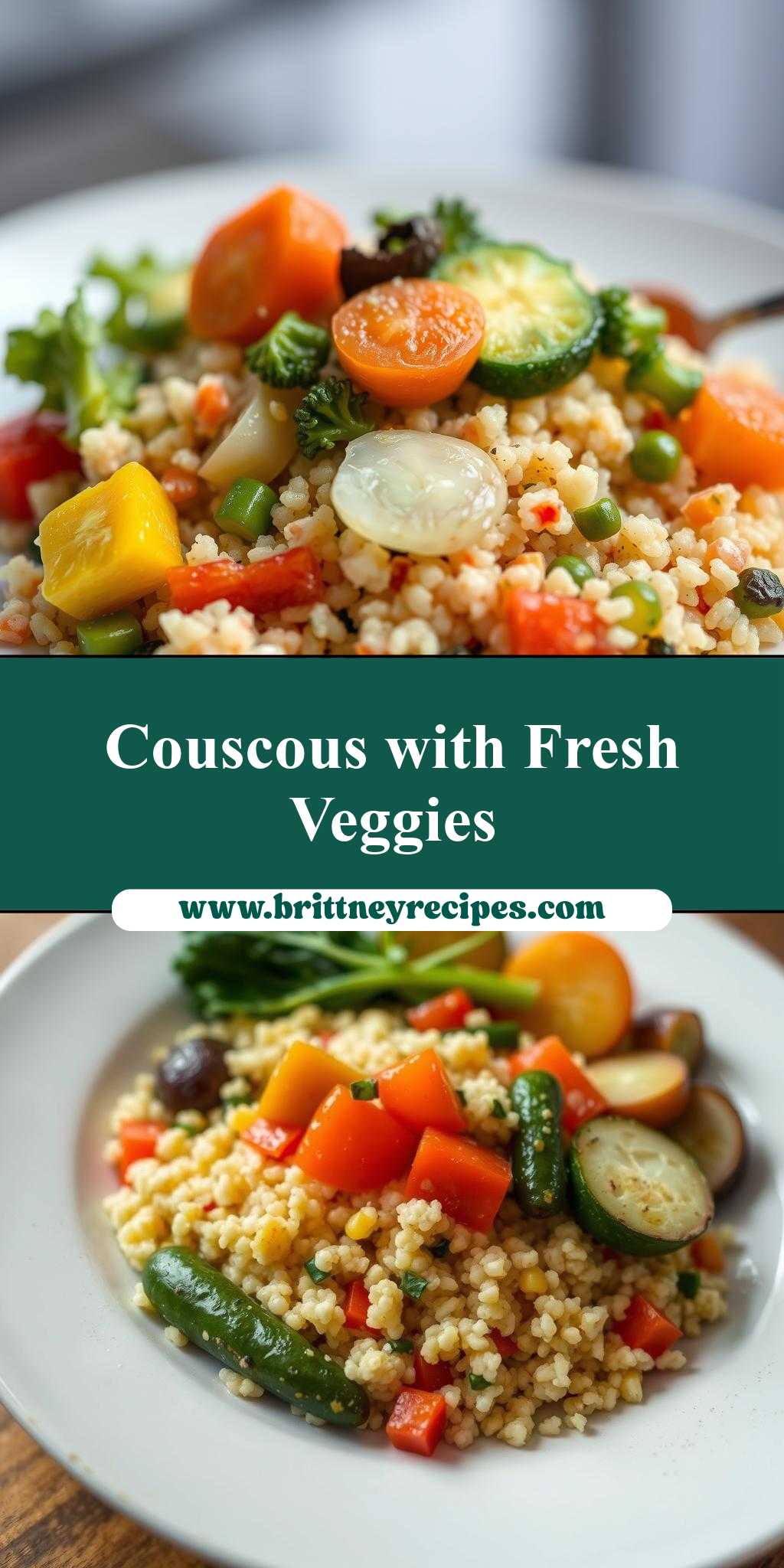What makes a perfect weeknight dinner? A hearty bowl of couscous with seven colorful vegetables, quickly cooked to perfection with tender loving care and a homemade touch, try sautéing your favorite vegetables like bell peppers and zucchini in olive oil. Save this easy recipe idea for a delicious and healthy family favorite meal. Try it soon
Couscous with Seven Vegetables
Introduction
Couscous with Seven Vegetables is a dish that embodies the perfect blend of ease, flavor, and creativity, using everyday ingredients to create a culinary masterpiece. This North African-inspired recipe is a celebration of colors, textures, and tastes, making it an ideal choice for a weeknight dinner or a special occasion. The beauty of this dish lies in its simplicity and flexibility, allowing you to experiment with a variety of vegetables and spices to suit your palate. Whether you’re a seasoned chef or a beginner in the kitchen, this recipe is sure to impress with its vibrant presentation and satisfying flavors.
Why This Works
- Flavor balance and ingredient accessibility: The combination of seven vegetables, along with the aromatic spices and herbs, creates a harmonious balance of flavors that is both refreshing and savory. The ingredients are easily accessible in most supermarkets, making this dish a practical choice for any meal.
- Ease of preparation: The steps involved in preparing Couscous with Seven Vegetables are straightforward and require minimal cooking expertise. The use of pre-cut vegetables and a simple cooking method ensures that the dish is ready in no time.
- Impressive results with minimal effort: Despite the simplicity of the recipe, the end result is a visually stunning and deliciously flavorful dish that is sure to impress family and friends. The vibrant colors of the vegetables and the fluffy couscous create a feast for the eyes, while the aromatic spices and herbs tantalize the taste buds.
Key Ingredients
The main ingredients in this recipe include couscous, a variety of vegetables such as carrots, zucchini, bell peppers, onions, tomatoes, cabbage, and broccoli, along with olive oil, garlic, ginger, cumin, coriander, paprika, salt, and black pepper. You can also add other vegetables like mushrooms, eggplant, or sweet potatoes to the mix, depending on your personal preferences. For a vegan version, you can omit any animal-based ingredients and use vegetable broth instead of chicken broth. Practical substitutions for the spices include using ground cinnamon instead of cumin or adding a pinch of cayenne pepper for an extra kick.
Instructions
- Step 1: Begin by preparing the vegetables. Chop the onions, carrots, zucchini, bell peppers, cabbage, and broccoli into bite-sized pieces. Mince the garlic and ginger, and set them aside. Measure out the spices, including cumin, coriander, paprika, salt, and black pepper.
- Step 2: Cook the couscous according to the package instructions. Typically, this involves boiling water, adding the couscous, covering the pot, and letting it steam for 5-7 minutes. Fluff the cooked couscous with a fork and set it aside.
- Step 3: In a large skillet, heat the olive oil over medium heat. Add the minced garlic and ginger and sauté for 1-2 minutes, until fragrant. Add the chopped onions and cook until they are translucent, about 3-4 minutes. Add the remaining vegetables, along with the spices, and cook until they are tender, about 10-12 minutes.
- Step 4: To assemble the dish, place the cooked couscous on a large serving platter or individual plates. Add the vegetable mixture on top of the couscous, and garnish with fresh herbs, such as parsley or cilantro. Serve hot, and enjoy!
Handy Tips
- Use a variety of colorful vegetables to create a visually appealing dish. You can also add other ingredients like nuts, seeds, or dried fruits to enhance the texture and flavor.
- Avoid overcooking the vegetables, as this can result in a mushy texture. Instead, cook them until they are tender but still crisp.
- Experiment with different spices and herbs to create unique flavor combinations. For example, you can add a pinch of cumin for a smoky flavor or a sprinkle of paprika for a smoky depth.
Heat Control
When cooking the vegetables, it’s essential to control the heat to prevent overcooking or burning. Medium heat is ideal for sautéing the vegetables, as it allows them to cook slowly and evenly. If using a skillet, make sure to stir the vegetables frequently to prevent them from sticking to the bottom. If using a steamer, ensure that the water is boiling before adding the vegetables, and adjust the heat as needed to maintain a steady steam.
Crunch Factor
The crunch factor in this dish comes from the variety of vegetables, which add texture and depth to the couscous. To achieve the perfect crunch, make sure to cook the vegetables until they are tender but still crisp. You can also add other crunchy ingredients like nuts, seeds, or dried fruits to enhance the texture. For example, you can sprinkle some toasted almonds or pumpkin seeds on top of the couscous for added crunch.
Pro Kitchen Tricks
- Use a pastry brush to apply olive oil to the vegetables, ensuring they are evenly coated and preventing them from sticking to the skillet.
- Add a splash of lemon juice or vinegar to the vegetables to enhance their flavor and texture.
- Use a microplane to grate the ginger and garlic, releasing their oils and flavors into the dish.
Storage Tips
- Store any leftovers in an airtight container in the refrigerator for up to 3 days. Reheat the dish in the microwave or on the stovetop, adding a splash of water or broth if needed to prevent drying out.
- Freeze the cooked couscous and vegetable mixture in airtight containers or freezer bags for up to 2 months. Reheat the dish in the microwave or on the stovetop, adding a splash of water or broth if needed to prevent drying out.
- Use glass or plastic containers with tight-fitting lids to store the dish, ensuring that it remains fresh and flavorful.
Gift Packaging Ideas
If you want to gift this dish to friends or family, consider packaging it in a decorative bowl or container, garnished with fresh herbs and a sprinkle of spices. You can also add a personalized note or card with the recipe and cooking instructions. For a more rustic presentation, use a wooden or wicker basket, lined with a colorful cloth or napkin. Add a few fresh vegetables or a bunch of herbs to the basket, along with a small bottle of olive oil or a spice blend, to create a thoughtful and practical gift.
Flavor Variations
- Different spices: Experiment with various spice blends, such as curry powder, chili powder, or smoked paprika, to add unique flavors to the dish.
- Creative toppings: Add some creative toppings, such as toasted nuts, seeds, or dried fruits, to enhance the texture and flavor of the dish.
- Ingredient swaps: Swap out some of the vegetables with other ingredients, such as mushrooms, eggplant, or sweet potatoes, to create a new and exciting flavor combination.
Troubleshooting
- Texture problems: If the vegetables are overcooked or mushy, try adding some crunchy ingredients like nuts or seeds to balance out the texture. If the couscous is dry or sticky, try adding a splash of water or broth to rehydrate it.
- Ingredient replacements: If you don’t have a particular ingredient, try substituting it with a similar ingredient. For example, you can use ground cinnamon instead of cumin or add a pinch of cayenne pepper for an extra kick.
- Over/undercooking signs: Keep an eye on the vegetables while they’re cooking, and adjust the heat as needed to prevent overcooking or burning. If the vegetables are undercooked, try cooking them for a few more minutes until they’re tender but still crisp.
FAQs
- Can I freeze it? Yes, you can freeze the cooked couscous and vegetable mixture in airtight containers or freezer bags for up to 2 months. Reheat the dish in the microwave or on the stovetop, adding a splash of water or broth if needed to prevent drying out.
- Is it gluten-free? Yes, this recipe is gluten-free, making it an excellent option for those with gluten intolerance or sensitivity. However, if you’re using a store-bought couscous, make sure to check the ingredients list to ensure that it’s gluten-free.
- Can I double the recipe? Yes, you can easily double or triple the recipe to feed a larger crowd. Just make sure to adjust the cooking time and heat as needed to prevent overcooking or burning.
Conclusion
Couscous with Seven Vegetables is a dish that is sure to become a staple in your kitchen, thanks to its ease of preparation, flexibility, and delicious flavors. Whether you’re a seasoned chef or a beginner in the kitchen, this recipe is perfect for any meal, from a quick weeknight dinner to a special occasion. So go ahead, get creative, and enjoy the process of cooking and sharing this wonderful dish with your loved ones. Don’t be afraid to experiment with different ingredients and spices to make the recipe your own, and don’t hesitate to reach out if you have any questions or need further guidance. Happy cooking!

